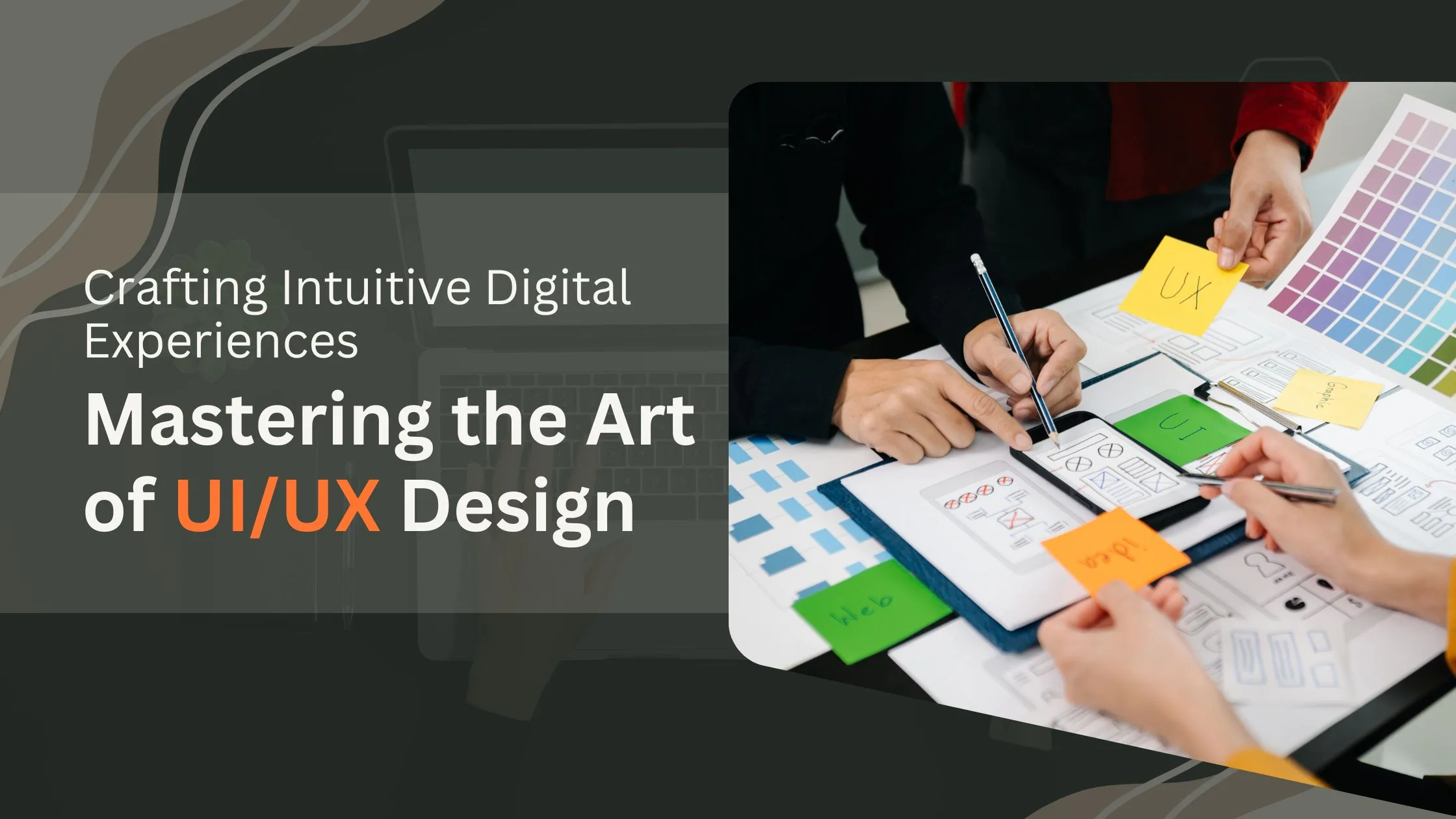Crafting Intuitive Digital Experiences: Mastering the Art of UI/UX Design
Welcome to the world of UI/UX design, where innovation and creativity collide to shape digital experiences that captivate and engage users. In this rapidly evolving era of technology, it’s not enough for a website or app to look visually appealing; it needs to seamlessly guide users through intuitive journeys that leave them wanting more.
The art of UI/UX design holds the key to unlocking this potential – and today, we’re delving deep into its mastery. Join us as we explore the intricacies of crafting intuitive digital experiences and uncover industry secrets that will transform your designs from good to unforgettable. Let’s dive in!
What is UI/UX Design?
UI/UX design is all about creating digital experiences that are both intuitive and engaging for users. This involves a deep understanding of how users interact with technology, and designing user interfaces and user experiences that are easy to use and enjoyable.
Good UI/UX design makes for happy users, which in turn makes for successful businesses. In today’s hyper-competitive digital world, UI/UX design can make or break a company. It’s that important.
There are two key components to good UI/UX design: usability and emotion. A well-designed experience must be easy to use, or else users will quickly get frustrated and give up. But it also needs to be emotionally appealing, or else users will lose interest and move on to something else.
The best UI/UX designs strike a perfect balance between usability and emotion, resulting in what is known as “delightful” experiences. These are the kinds of experiences that leave users feeling satisfied, engaged, and coming back for more.
The Role of User Interface and User Experience in Digital Design
User interface (UI) and user experience (UX) design are two of the most important aspects of digital design. They both focus on how users interact with digital products and how those products can be made more user-friendly.
UI design is all about the look and feel of a product. It’s concerned with how a product looks and how easy it is to use. UX design, on the other hand, is all about improving the overall experience of using a product. It takes into account things like how easy it is to find the information you need, how intuitive the navigation is, and whether or not the overall experience is enjoyable.
Both UI and UX design are important for crafting intuitive digital experiences. A good UI can make a product more visually appealing and easier to use, while a good UX can make a product more enjoyable to use and easier to navigate.
When designing digital products, it’s important to take both UI and UX into consideration. By focusing on both aspects of design, you can create products that are not only easy to use but also enjoyable to use.
Tips and Strategies for Creating an Intuitive Digital Experience
1. Keep it simple: When it comes to crafting intuitive digital experiences, less is almost always more. When users are presented with too many options or complex tasks, they can easily become overwhelmed and frustrated. Instead, focus on streamlining the user experience by keeping things clean and simple.
2. Make it visually appealing: Another important aspect of creating an intuitive digital experience is making sure that your interface is visually appealing. Users should be able to easily navigate your site or app without getting lost in a sea of cluttered graphics or confusing text.
3. Prioritize usability: In the end, the most important thing to keep in mind when crafting an intuitive digital experience is that it should be easy and enjoyable to use. Always put usability first and make sure that your interface is logical, efficient, and user-friendly.
Tools and Resources for UX Designers
As a UX designer, it’s important to have a toolkit of resources at your disposal to help you create intuitive digital experiences. Here are some essential tools and resources for UX designers:
1. Sketch: A vector drawing and animation software that’s great for designing user interfaces, wireframes, and prototypes.
2. Adobe XD: Another vector drawing and animation software that’s perfect for designing user interfaces and prototypes. It has an intuitive interface and offers a free trial.
3. InVision: A web-based prototyping platform that allows you to create clickable prototypes of your designs. It also has a free trial period.
4. Justinmind: A desktop prototyping tool that lets you create fully interactive prototypes of your designs. It offers a free version with limited features.
5. Balsamiq: A wireframing tool that helps you quickly create low-fidelity prototypes of your designs. It offers a free trial version.
Crafting Engaging Interactions with Usability Testing
When it comes to crafting intuitive digital experiences, usability testing is a crucial part of the process. By testing with real users, you can gain insights into how they interact with your app or website and what areas need improvement.
Usability testing doesn’t have to be complicated or time-consuming. There are many different types of usability tests that can be conducted,depending on your needs and resources. Here are a few tips for conducting effective usability tests:
1. Define your goals. What do you want to learn from the usability test? What areas do you want to improve? Keep your goals in mind when designing your test and selecting participants.
2. Select the right type of test. There are many different types of usability tests, from formal lab studies to informal user interviews. Choose the type of test that will best help you achieve your goals.
3. Recruit participants who match your target audience. It’s important to test with users who are representative of your target audience. Otherwise, you won’t be able to accurately assess how they will interact with your app or website in the real world.
4. Make sure the test is structured and well-run. A well-structured usability test will ensure that you get useful data from participants. Make sure to give clear instructions and provide adequate time for participants to complete tasks.
5 . Ask the right questions . Avoid leading questions that could bias results, and focus on open-ended questions that will give you additional insight into the user experience.
By following these tips, you can ensure that your usability tests are effective and provide valuable data for improving user interactions.
Common Mistakes to Avoid When Designing a UI/UX
1. Don’t forget the user’s needs – always keep the user’s needs in mind when designing a UI/UX. Consider what they need to accomplish and design around that.
2. Don’t make things too complicated – make sure your design is simple and easy to use. Too much complexity will only frustrate users and turn them away from your product.
3. Don’t underestimate the power of first impressions – first impressions are critical in UI/UX design. Make sure your design makes a good impression on users right from the start.
4. Don’t neglect feedback – gather feedback from users during the design process and use it to improve your UI/UX. Without feedback, you won’t know what works and what doesn’t work for your users.
Preparing Your Project for Launch
Preparing your project for launch can be a daunting task, but with a little planning and attention to detail, it can be a seamless process. Here are a few tips to help you get started:
1. Define your goals and objectives. What are you hoping to achieve with your project? take the time to sit down and map out what success looks like for you. This will help you focus your efforts and keep you on track as you move forward.
2. Assemble your team. Your team will be integral in helping you bring your vision to life, so it’s important to choose wisely. Consider their skillsets and experience, as well as their willingness to work collaboratively towards a common goal.
3. Create a plan of action. Once you have your team in place, it’s time to start mapping out how you’ll achieve your objectives. This plan should include milestones, deadlines, and assigned tasks so everyone knows what needs to be done and when.
4.Size up your competition . Before you launch, it’s important to understand who your competition is and what they’re offering. This research will help inform your own strategy and give you an idea of what challenges you may face along the way.
5. Promote, promote, promote! Once everything is in place and ready to go, it’s time to start spreading the word about your project . use all available channels (social media , email marketing , PR , etc.)
Conclusion
Crafting intuitive digital experiences is a challenging but rewarding task, and mastering the art of UI/UX design is an essential skill that every aspiring designer must possess. From understanding basic principles such as typography and layout to account for human behavior through user psychology, this article has outlined numerous concepts and tips to ensure your designs will have maximum impact on users’ overall experience. With dedication, practice and mindful application of techniques discussed here, you too can become a master in crafting interactive experiences that not only captivate users but also lead to tangible business outcomes.





